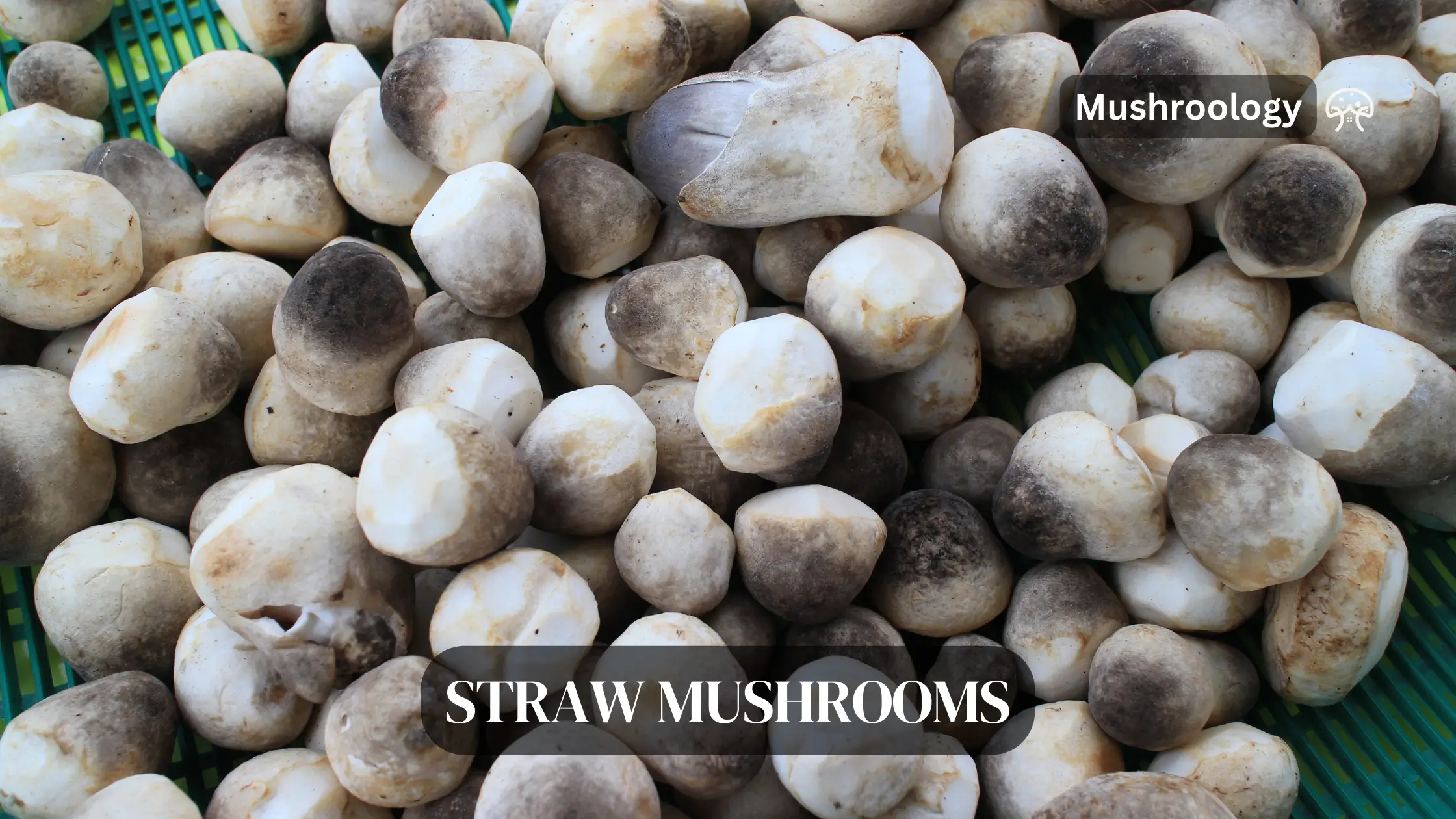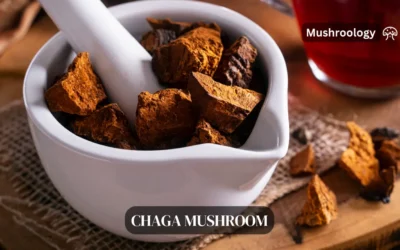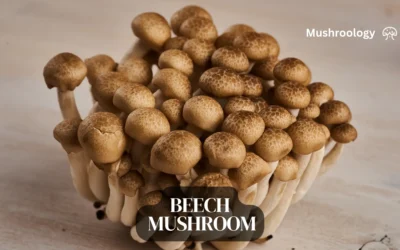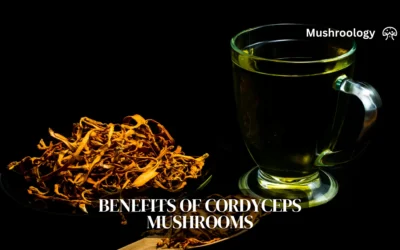Straw mushrooms, also known as paddy straw mushrooms (Volvariella volvacea), are a popular and easy-to-grow variety perfect for home cultivation. This guide provides a comprehensive step-by-step process for growing these delicious mushrooms, even for beginners.
What are Straw Mushrooms (Volvariella Volvacea)
Straw mushrooms, by the scientific name Volvariella volvacea, belong to the family Pluteaceae. They are saprobic fungi, meaning they obtain nutrients from decomposing organic matter, such as straw.
Origin and Cultivation:
- Native to Southeast Asia, particularly in tropical and subtropical regions.
- Widely cultivated throughout Asia and gaining popularity in other parts of the world due to their ease of growth and high nutritional value.
- Thrive in warm and humid environments with optimal temperatures between 25-30°C (77-86°F) and high humidity levels (80-90%).
Physical Characteristics:
- Cap: Initially egg-shaped, expanding to become bell-shaped or convex with maturity. Colour ranges from light brown to dark brown, sometimes with a slight reddish hue.
- Gills: Free, white to cream-colored, and closely spaced.
- Stem: Cylindrical, white to light brown, and often with a sac-like structure (volva) at the base.
- Spores: Ellipsoidal, smooth, and light brown in color.
Nutritional Value:
- Low in calories and fat.
- Good source of protein, dietary fiber, vitamins (including B vitamins, vitamin C, and vitamin D), and minerals (including potassium, phosphorus, and iron).
- Contain unique bioactive compounds with potential health benefits, such as anti-inflammatory and antioxidant properties.
Life Cycle:
- Mycelium: The vegetative stage of the fungus, consisting of thread-like filaments that colonize the substrate (straw).
- Fruiting bodies: The mushrooms we see and harvest, which develop from the mycelium and are responsible for spore production for reproduction.
Ecological Role:
- Play an important role in decomposing organic matter, contributing to nutrient cycling in ecosystems.
- Can be used in bioremediation efforts to degrade agricultural waste and pollutants.
Additional Scientific Information:
- Recent research has focused on the genome sequencing of Volvariella volvacea, providing insights into its genetic makeup and potential for strain improvement.
- Studies are also investigating the medicinal properties of various bioactive compounds found in straw mushrooms, exploring their potential applications in human health.
What You’ll Need for Growing Straw Mushrooms

Growing delicious straw mushrooms at home requires a few essential tools and materials. Here’s a detailed breakdown of what you’ll need:
1. Straw:
- Type: Choose clean, dry, and pesticide-free straw.
- Recommended options: Rice or wheat straw are ideal due to their readily digestible cellulose content. Other options like oat straw or barley straw can also work, but may require slightly longer soaking times.
- Quantity: Aim for approximately 1 kg (2.2 lbs) of straw for a single cultivation cycle. This amount can be adjusted based on the size of your container and desired yield.
2. Mushroom Spawn:
- Species: Purchase high-quality Volvariella volvacea spawn from a reputable supplier. This ensures you’re getting the specific fungal strain suitable for growing straw mushrooms.
- Form: Spawn typically comes in various forms like grain spawn or sawdust spawn. Both options work well, but grain spawn may colonize the straw slightly faster due to its readily available nutrients.
- Quantity: Generally, a spawn-to-substrate ratio of 1:10 is recommended. For 1 kg (2.2 lbs) of straw, you’ll need around 100 g (3.5 oz) of spawn.
3. Container:
- Type: Choose a large container with good ventilation to allow for air circulation and prevent moisture buildup. Plastic tubs, buckets, or even large grow bags with ventilation holes can work well.
- Size: The size of the container will depend on the amount of straw you’re using. Aim for a container that can comfortably hold the straw without being crammed, allowing for some space for air circulation. A 50 L (13 gallons) container is a good starting point for 1 kg (2.2 lbs) of straw.
4. Hydrated Lime:
- Function: Adding hydrated lime (calcium hydroxide) to the soaking water helps regulate the pH level of the straw, creating a slightly alkaline environment that favors the growth of Volvariella volvacea while suppressing potential contaminants.
- Quantity: Use approximately 50 g (1.75 oz) of hydrated lime per liter (gallon) of water during the soaking process.
5. Spray Bottle:
- Purpose: A clean spray bottle filled with water will be essential for maintaining humidity inside the container throughout the growing process.
6. Thermometer:
- Importance: Monitoring the temperature is crucial for optimal mushroom growth. A thermometer will help you ensure the environment stays within the ideal range for Volvariella volvacea (25-30°C / 77-86°F).
Optional Equipment:
- Gloves: Wearing gloves while handling the straw and spawn can help maintain hygiene and prevent contamination.
- Heat Mat: If you struggle to maintain consistent warm temperatures, a heat mat placed underneath the container can provide supplemental warmth.
Additional Considerations:
- Water quality: Use clean, chlorine-free water for soaking the straw and maintaining humidity.
- Lighting: Straw mushrooms do not require direct sunlight. Avoid exposing the container to bright light, as this can inhibit growth.
By gathering these essential tools and materials, you’ll be well-equipped to embark on your journey of growing delicious straw mushrooms at home.
- Straw: Choose clean, dry, and pesticide-free straw, preferably rice straw or wheat straw. (1 kg / 2.2 lbs)
- Mushroom Spawn: Purchase high-quality Volvariella volvacea spawn from a reputable supplier. (100 g / 3.5 oz)
- Large container: A plastic tub, bucket, or bag with good ventilation holes (around 50 L / 13 gallons)
- Hydrated lime: Helps regulate pH and prevent contamination. (50 g / 1.75 oz)
- Spray bottle: For maintaining humidity
- Thermometer: To monitor temperature
Step-by-Step Instructions for Growing Straw Mushrooms
Growing straw mushrooms at home involves a straightforward process, but following each step carefully is crucial for successful cultivation. Here’s a detailed guide with scientific explanations for each step:
1. Prepare the Straw:
- Chopping: Cut the straw into small pieces, ideally between 3-5 cm (1-2 inches) in length. This size provides optimal surface area for efficient fungal colonization while maintaining good air circulation within the substrate.
- Soaking: Submerge the chopped straw in a large container filled with lukewarm water (around 30°C / 86°F) for 24-48 hours. This process hydrates the straw, making it easier for the fungal mycelium to colonize and absorb nutrients.
- Adding Hydrated Lime: During soaking, add approximately 50 g (1.75 oz) of hydrated lime per liter (gallon) of water. The slightly alkaline environment created by lime helps suppress the growth of competing bacteria and fungi while favoring the growth of Volvariella volvacea.
- Draining: After the soaking period, thoroughly drain the straw using a colander or mesh sieve. Squeeze out excess water gently, aiming for the straw to be moist but not dripping. Excessive moisture can lead to contamination and hinder fungal growth.
2. Pasteurization (Optional):
- Purpose: Pasteurization is an optional step that helps eliminate potential contaminants like bacteria and mold spores that may be present in the straw. While not strictly necessary for all situations, it can improve the chances of successful cultivation, especially for beginners.
- Methods: There are two common methods for pasteurizing straw:
- Submersion: Bring a large pot of water to a boil. Place the straw in a heat-resistant mesh bag or colander and submerge it in the boiling water for 1-2 hours. Maintain a rolling boil throughout the process.
- Steaming: Spread the straw on a baking sheet and steam it for 1-2 hours using a steamer or pot with a steamer basket. Ensure adequate steam is generated and reaches all parts of the straw.
- Cooling: After pasteurization, allow the straw to cool completely before proceeding to inoculation. This typically takes several hours.
3. Inoculate the Straw:
- Spreading the Straw: Evenly distribute the cooled and prepped straw in the chosen container. Aim for a loose and fluffy arrangement to allow for proper air circulation and prevent compaction.
- Adding Spawn: Break up the mushroom spawn into small pieces and sprinkle it evenly over the surface of the straw. Ensure good distribution throughout the substrate.
- Mixing: Gently mix the top layer of straw with the spawn, incorporating it slightly without disturbing the overall structure of the substrate. This ensures close contact between the spawn and the straw, facilitating fungal colonization.
4. Create a Humid Environment:
- Covering: Cover the container loosely with a plastic bag or cloth that allows for some air exchange. This helps trap moisture inside and maintain high humidity levels necessary for fungal growth.
- Misting: Regularly mist the inside of the container with clean water using the spray bottle. Aim for a fine mist that creates a humid environment without saturating the straw.
5. Maintain Ideal Conditions:
- Temperature: Place the container in a warm location with temperatures between 25-30°C (77-86°F). This temperature range is optimal for the growth of Volvariella volvacea. If needed, use a heat mat placed underneath the container to maintain consistent warmth.
- Humidity: Monitor the humidity level inside the container and maintain it around 80-90% by misting regularly and adjusting the ventilation as needed. Too much humidity can lead to mold growth, while insufficient moisture can hinder fungal development.
- Lighting: Avoid exposing the container to direct sunlight. Straw mushrooms do not require light for growth and may even be inhibited by excessive light exposure.
6. Incubation and Fruiting:
- Mycelial Colonization: Allow the container to remain undisturbed for 7-10 days. During this incubation period, the fungal mycelium will colonize the straw, spreading throughout the substrate as white threads become visible.
- Fruiting Body Formation: Once the straw is fully colonized, small pinheads will begin to form on the surface, indicating the initiation of fruiting body development. This typically takes another 3-5 days.
7. Harvest and Enjoy:
- Maturity: Harvest the mushrooms when the caps are fully expanded but before the veil breaks (the thin membrane connecting the cap to the stem). This ensures optimal flavor and texture.
- Harvesting Technique: Gently twist the mushrooms at the base to detach them from the substrate. Avoid pulling or cutting, as this can damage
Tips for Success in Growing Straw Mushrooms
Following the outlined steps is crucial, but incorporating these additional tips can significantly enhance your chances of cultivating healthy and abundant straw mushrooms:
Maintaining Optimal Conditions:
- Consistent Humidity: Fluctuating humidity levels can stress the mycelium and hinder fruiting. Aim for consistent moisture levels around 80-90% throughout the cultivation process. Monitor humidity regularly and adjust misting frequency or ventilation as needed.
- Proper Air Circulation: While maintaining humidity is important, stagnant air can promote mold growth. Ensure the container has adequate ventilation holes to allow for some air exchange. Briefly remove the cover for a few minutes daily to refresh the air, especially during fruiting.
- Temperature Control: Volvariella volvacea thrives in warm temperatures. Maintain consistent temperatures between 25-30°C (77-86°F) throughout the process. If using a heat mat, ensure it doesn’t directly touch the container to avoid overheating the substrate.
Hygiene and Sanitation:
- Cleanliness: Wash your hands thoroughly before handling the straw, spawn, and mushrooms. This helps prevent contamination from introducing unwanted bacteria or fungi.
- Sterilization: Consider sterilizing the container and tools used in the process with a diluted bleach solution or rubbing alcohol before use. This further minimizes the risk of contamination.
Additional Tips:
- Spawn Quality: Choose high-quality, fresh spawn from a reputable supplier. This ensures the viability of the fungal spores and increases the chances of successful colonization.
- Avoiding Direct Sunlight: While light is not necessary for growth, Volvariella volvacea can be sensitive to direct sunlight. Keep the container in a shaded location or covered to prevent potential negative effects.
- Monitoring and Observation: Regularly check the container for signs of mold growth, which appears as fuzzy patches of different colors. If mold is present, isolate and discard the contaminated material immediately to prevent further spread.
- Multiple Flushes: After the initial harvest, the straw may produce additional flushes of mushrooms over a period of several weeks. Continue maintaining optimal conditions and harvesting as new mushrooms appear.
- Spent Substrate: Once fruiting has ceased, discard the spent straw and thoroughly clean the container before starting a new cultivation cycle.
By following these tips and paying close attention to the details throughout the process, you can create a favorable environment for your straw mushrooms to thrive and enjoy a rewarding harvest of delicious and nutritious homegrown fungi.
FAQs about Growing Straw Mushrooms:
1. What type of straw is best for growing straw mushrooms?
Answer: Rice straw or wheat straw are ideal choices due to their readily digestible cellulose content. Other options like oat straw or barley straw can also work, but may require slightly longer soaking times.
2. Where can I buy mushroom spawn for growing straw mushrooms?
Answer: You can purchase high-quality Volvariella volvacea spawn from reputable online mushroom suppliers or specialty gardening stores.
3. What is the ideal temperature for growing straw mushrooms?
Answer: The optimal temperature range for Volvariella volvacea is between 25-30°C (77-86°F). If needed, use a heat mat to maintain consistent warmth.
4. How often should I mist the container during cultivation?
Answer: Misting frequency depends on humidity levels. Aim to maintain consistent moisture around 80-90%. Mist regularly as needed to create a humid environment without saturating the straw.
5. How long does it take for straw mushrooms to grow?
Answer: It typically takes around 7-10 days for the mycelium to colonize the straw, followed by another 3-5 days for fruiting bodies to form. The entire process from inoculation to harvest can take 2-3 weeks.
6. How many flushes of mushrooms can I expect from one batch of straw?
Answer: Under optimal conditions, you can typically harvest multiple flushes of mushrooms over a period of several weeks. The number of flushes can vary depending on various factors like spawn quality and environmental conditions.
7. What do I do with the spent straw after harvesting?
Answer: Once fruiting has ceased, discard the spent straw and thoroughly clean the container before starting a new cultivation cycle. You can compost the spent straw as it can still contain some nutrients beneficial for plants.
8. Can I eat straw mushrooms raw?
Answer: It’s generally not recommended to eat straw mushrooms raw. Cooking helps ensure their safety and digestibility. They can be enjoyed in various cooked dishes like stir-fries, soups, or omelets.
9. What are the health benefits of straw mushrooms?
Answer: Straw mushrooms are low in calories and fat and a good source of protein, dietary fiber, vitamins, and minerals. They also contain unique bioactive compounds with potential anti-inflammatory and antioxidant properties.
10. Is growing straw mushrooms difficult?
Answer: Growing straw mushrooms is considered a relatively easy and beginner-friendly option compared to other mushroom varieties. By following proper procedures and maintaining suitable conditions, you can successfully cultivate these delicious fungi at home.





